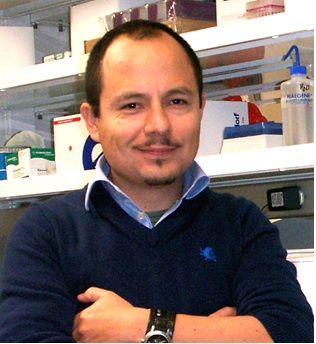At ASTMH in Peru, Sandy Olkowski -- a PhD candidate in entomology at the University of California, Davis, and an active trainee in the ASTMH Committee on Global Health -- connected with Alejandro Castellanos-Gonzalez, PhD, a new memer of the Society who has attended the Annual Meeting for most of his career. Castellanos-Gonzalez is an Assistant Professor at the Department of Internal Medicine, Division Infectious Diseases at the University of Texas Medical Branch in Galveston.
The following Q&A is based on Olkowski's conversation with Castellanos-Gonzalez in Lima.
 1. You have participated in many ASTMH Annual Meetings – starting from when you were a student. What made you first want to participate in the meeting and how has it affected your career over the years?
1. You have participated in many ASTMH Annual Meetings – starting from when you were a student. What made you first want to participate in the meeting and how has it affected your career over the years?
I’ll put in this way, if you like soccer then what you want is to attend to the World Cup, and if you are an international student working in infectious diseases then what you want is to go to ASTMH. Why? Basically for its excellent reputation.
When I was student at the National University of Mexico, I had a lot of curiosity about ASTMH meetings because I knew about its reputation and because I knew I could have a unique opportunity there to meet outstanding people in the field of infectious diseases. The ASTMH meetings have had a huge impact on my career, since I first presented posters as student, then I had my first oral presentation as a post-doc, and during the last meeting in New Orleans I had the opportunity to co-chair my first scientific session now as faculty. And who knows, maybe one day I'll give my first plenary session at ASTMH.
2. You were an international student when you first presented research at an ASTMH Annual Meeting. Thinking back on those days, what advice would you give international students who are just getting introduced to the Society?
I remember my first international meeting. Before I traveled, my lab mates told me that I should not be disappointed if no one showed up at my poster. They recommended that I stay in front of my poster for half an hour and then to do some tourism. I decided to stay and present my poster, but they were right - no one approached my poster during the first hour. Then that changed. I remember this guy that came to my poster as the first person and said that he had been in Mexico when he was student, so we had an excellent conversation. He was very kind and gave me a lot of recommendations and at the end we said we should be in contact.
I returned to Mexico very motivated and finished my PhD. The researcher who visited my poster – Dr. Clinton White, Jr. – is currently the head of the division of infectious diseases at UTMB, and 15 years later he continues giving me advice. Only now I’m an Assistant Professor at UTMB and he is my boss! So my advice for students is to stay in front of your poster and interact with as many people as you can because you always will learn something new. And most importantly, don’t feel afraid to speak with people even if your English is not perfect because what is important is to communicate your ideas.
3. ASTMH values active participation of students and trainees. How can the Society expand on its efforts to support students and trainees?
ASTMH already gives a lot of value to their students and trainees, so it is difficult to suggest something when things are well done. My only suggestions are to continue doing what you are doing and also improve the interaction with students by incorporating new technologies like social media. I think that social media can be used to share the experiences of people working in the infectious disease field in different parts of the world. I think that would be very motivating for students because they could see (in real time) the amazing things that ASTMH members are doing to improve health of people, and that could inspire them to develop novel ideas in the near future. But as I said, I think ASTMH is doing a great job.
4. Broadly communicating our research is becoming increasingly important for scientists. How would you explain to a non-scientist the importance of your work on point-of-care diagnostics for neglected parasitic diseases?
My mother is 78 years old and she always asks me about my research. I try to be very patient and highlight the important things without giving technical details. So every time that I speak with non-scientist audiences I try to do the same thing. Also I give easy examples. For instance, when I explain that "a point of care diagnostic" is something like a pregnancy test but applied to infectious diseases. Then people instantly understand what I'm doing.
5. You recently attended ASTMH in Peru. What were some of the highlights?
It was an amazing experience. I was impressed by all the field work that is being conducted in Peru. Speaking with students and researchers was very important for my research because I made a lot of connections and decided to collaborate on several projects there. So far, most of my work has been done in the lab so now I’m very excited because thanks to this trip for the first time I will have the opportunity to bring my research to the field. The fact that this research could have a real impact on the health of the population makes me very happy.
---
ASTMH members are the best and the brightest in their field. Our member interviews highlight our diverse and growing membership. To read other member profiles, click here.